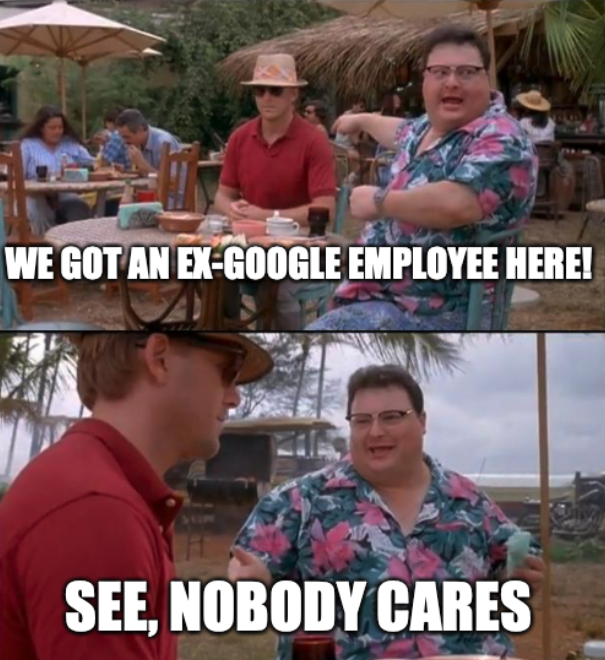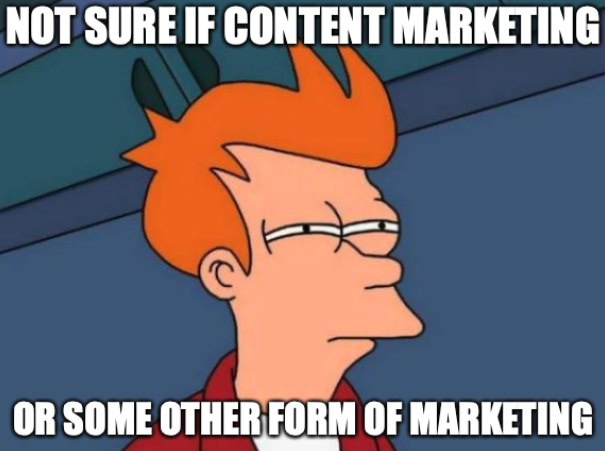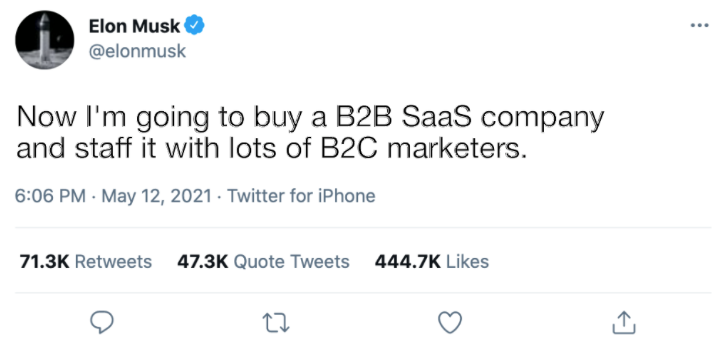Marketing is Broken: Sacred Cows
Assumptions are made in marketing. Those assumptions morph into expectations and sacred cows, making marketers less creative and efficient.

There are a lot of assumptions made in marketing. Over time, those assumptions morph into expectations and, finally, sacred cows, making marketers less creative and efficient. My hope is that over time this list of sacred cows becomes outdated as companies learn from mistakes.
🤩 Big Company = Less Marketing Impact 📉
I see it all the time on LinkedIn profiles. For example, "Ex-Google", "Ex-Meta" or "Ex-McKinsey." Great, you worked at a really big brand or agency. Now, actually tell me what you did and achieved. The likelihood you moved the needle incrementally on important KPIs like revenue or conversions is very small, as the larger the company:
- The more brand momentum there is at play, meaning a huge chunk of "performance" is you piggybacking on past successes and market position.
- Most of your time is spent on meetings, presentations, internal politics, etc., which means less time doing actual work.
- The likelihood you're running campaigns soup to nuts (from ideation to copywriting to design to execution to optimization and reporting) is low and instead you're leveraging discreet team members and agencies to do each part and mostly doing project management.

💰 Managing Spend ≠ Optimizing Spend ✅
Please, stop putting on job postings, "Must have managed $X in advertising spend."
Unfortunately, this is used as a qualifier to weed out top-performing marketers as some of the more scrappy marketers that are used to doing more with less money (and showing good results) get rejected in favor of those that were lucky enough to work at a big brand or a company in hyper-growth mode that is throwing way too much money at advertising.

And there's a dirty secret that comes along for the ride: since most campaigns are executed by agencies or self-service, programmatic platforms, the difference between "managing" a spend of $X vs. $Y is simply the number of decimal places on an insertion order or line item.
👉 All Marketing is Content Marketing 👈
"Content marketing" wasn't even a thing more than a decade ago and then all of a sudden it was everywhere – in job requirements and even in titles. But what makes one type of marketing collateral content marketing vs. another type, well, not? After all, all marketing requires some form of content.
There seems to be a demarcation where things like blogs, white papers, infographics (and sometimes emails) fall under the umbrella of content marketing but things like social media posts, PPC and display ads and landing pages do not.

When you break it down like above, it really is a distinction between long-form and short-form content and shouldn't a marketer be able to do both?
My guess is the rise of the "content marketer" title came to be as folks weren't satisfied with noting they were primarily a writer of words (copywriter) vs. images or videos (graphic designer or video producer).
🧑 Marketing Personas Are Useless 🧻
I don't care what you call them – they can be buyer legends, personas, cohorts, psychographics, etc. – I've never seen them to be an effective use of time or money at any company.
Here are the main issues I often see with personas:
- They represent some mythical version of who the company wished their ideal customer is not who their actual customers are.
- They're loaded with generic demographic and other descriptive information that isn't actionable.
Let's say you have a D2C ecommerce company that ships organic baby food to a subscribers on a monthly basis. The company might write multiple personas, with one being like this:
Betty is a 30-year old white female. She has a newborn, a five-year-old and a husband. She lives in the suburbs of a major city and drives an electric car. She donates to environmental causes, is a college graduate and has disposable income.
And it's common to see the story of someone like Betty go on and on and on ... and then there will be other personas, all with long-winded stories. The personas then get circulated at the company and everyone is told to become familiar with them and adopt as much of their marketing strategy and tactics to the personas.
What you're seeing shake of out the persona methodology is a less efficient way of doing and packaging up customer research, and solving customer pain points.

If we go back to the made-up D2C ecommerce company that ships organic baby food to a subscribers home on a monthly basis, what's more efficient: writing five-to-10 personas or simply knowing your customer base and working on solving the most common, revenue-generating pain points?
Instead of personas, you might have a much more high-level strategy like this:
- Stress the quality of the food, i.e., its organic status and healthy ingredients.
- Make the subscription model simple, e.g., get started with one free shipment, cancel at any time, get reminders one week before a shipment (so you can reschedule or cancel), etc.
- Address what competitors offer and how you do it better.
- What friction exists within the buyer journey? How can I address that?
- Where are my potential buyers going to learn about organic baby food and what language (and phrases) do they use when talking about it?
But, I can hear you saying, "Your approach is super broad and not hyper personalized."
Yes, exactly. I would much rather address true aggregates instead of hyper-specific buyer types (that may or may not exist). The first or broad approach scales, the second does not, and with more and more privacy regulation, super-specific personalization will only get harder over time.
🙇♀️ Sorry, B2B, You're Not Special 😢
B2B may be the most cliquish of any type of marketing. It's far more common to see people make the jump from B2B to B2C vs. the other way around. In fact, you'll see B2B job descriptions that distinctly ask for years of B2B-specific experience and completely discount the same amount (or more) of B2C experience.
Given they're both selling to people are there any other distinctions? In B2C, the consumer is in charge of the purchase path (most of the time), i.e., they decide they want to buy a product or service and either call, go to a website or go to a store to get the product. In B2B, buying direct is less common and instead, demos are done and salespeople are involved, and the decision maker may have to run the vendor through an approval and vetting process.
Most B2C marketers are actually used to not needing sales teams to make, well, sales whereas most B2B marketers often rely on sales teams for that very function.
And for both it should come down to revenue (but sadly often doesn't) – whether you call that LTV, NPV, ARR or something else.
The take home: B2C marketers can bring a lot to B2B, so to those recruiting B2B roles, stop rejecting candidates with mostly B2C experience – you're leaving a lot of creative, eligible talent on the table.

Plus, and this applies to any vertical or aspect of marketing: those with similar experience but outside your niche area often bring the most innovative ideas as they haven't been stuck in an echo chamber for years.
📢 Marketing = Branding 💖
Michael Lorenzos has written an excellent article where he notes that brand vs. performance marketing is a false dichotomy. And I wholeheartedly agree with him. Yet, the dichotomy persists. You'll often see a marketing team split up into separate brand and performance (or growth) teams.
The reason this distinction probably persists is because brand teams tend to focus on top of the funnel (or awareness) and performance or growth teams tend to focus on middle-to-bottom of the funnel (engagement and conversion). And brand teams will often claim they can't measure ROI so they'll use KPIs like brand awareness, equity and recall.
And yes, those types of brand metrics – like brand equity – should translate into bottom-line revenue or ROI. For example, if brand equity is truly going up, you should see less churn, quicker purchase cycles, more LTV or ACV, etc.
But let's think through this. If I run a Facebook ad, does it not contain the brand's name and logo? And if it's effective, i.e., drives a conversion or sale, does it not bolster the brand? After all, a customer can be a brand advocate, but it's very unlikely for a non-customer to be.
And on the flip side, if I run a top-of-funnel campaign campaign aimed at raising awareness, does that not prime the potential customer to pick my brand when they're further in the decision-making process or nearing the bottom of the funnel?

I can't tell you how many times I've seen "performance" marketing campaigns not convert quickly and then that eventually-converting traffic comes back as organic or direct and gets claimed as brand or SEO.
A more powerful distinction would be not be having separate brand vs. performance marketers but figuring out how to allocate internal resources and budgets across the stages of the funnel, and how the messaging differs.
